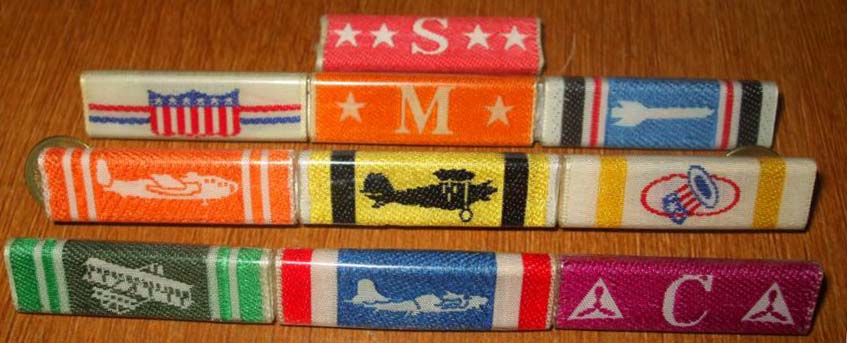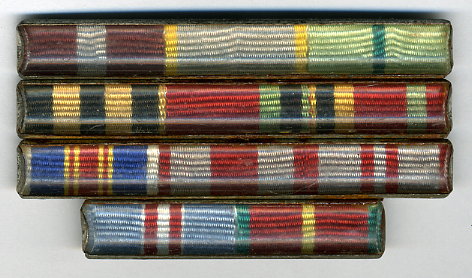Plastic Ribbons
I have Plastic WW1 Victory Medal Ribbons as well as
others from WW2.
see
for an article on Ebay which talks of Plastic Ribbons. as of
12/06/2011
From a 1944 patent application by Joseph Wolf of the Wolf-Brown
Company.
The primary object of my invention is to provide a service ribbon or
campaign bar that is protected against wear and soil and at the same
time
may be removably attached either as a single unit or in multiple units
to a mounting bar without 30 supplemental fasteners.
Click here for
picture and text from Google
as of 10/03/2017 or look up patent number 2,392,351
Plastic Ribbons are as described in the patent,
this does not mean the ones that had a
plastic/nitrate
flim over the Ribbon that yellowed with age and which also cracked
easily.
 Patented Jan. 8, 1946, 2,392,351, UNITED STATES PATENT
OFFICE,
2,392,351
CAMPAIGN BAR AND MOUNTING THEREFOR
Joseph Wolf, Beverly Hills, Calif., assignor to Sylvan Wolf, Los
Angeles,
Calif.
Patented Jan. 8, 1946, 2,392,351, UNITED STATES PATENT
OFFICE,
2,392,351
CAMPAIGN BAR AND MOUNTING THEREFOR
Joseph Wolf, Beverly Hills, Calif., assignor to Sylvan Wolf, Los
Angeles,
Calif.
Application January 29, 1944, Serial No. 320,231
1 Claim. (CI. 40—1.5)
The present invention relates to new and useful improvements in the
method of-constructing laminated ribbon campaign bars and to provide
for
their iriterchangeability of position on mounting bars when necessity
requires
their removal 6 from one mounting bar to another, or when a change of
position
on the same bar is necessary to maintain their order of precedence.
Both the Army and the Navy use service ribbons for their decorations
and medals during war- Iq time. The Army decoration service ribbons are
worn in one or more lines in the sequence of their importance starting
on the top row toward the center of the body and reading leftward,
followed
by medal service ribbons in the sequence earned, is When more than one
line of ribbons are worn, such lines will overlap.
Since the most distinguishing decorations for valor are sometimes
awarded
subsequently to those of a less distinguishing character, it becomes
necessary
to adjust the arrangement from left to right in order to conform to the
Army and Navy requirements of wearing decorations, service medals and
badges
in the prescribed order of precedence. . 25
The primary object of my invention is to provide a service ribbon or
campaign bar that is protected against wear and soil and at the same
time
may be removably attached either as a single unit or in multiple units
to a mounting bar without 30 supplemental fasteners.
Another object of my invention is to provide a laminated service
ribbon
or campaign bar resulting in-a single unitary article provided with
means
for interchangeably mounting the same on 35 a supporting bar without
additional
fastening elements.
Still other objects, advantages and features of invention will
hereinafter
appear.
Referring to the accompanying drawing which 40 illustrates further
improved
embodiments of the invention over that shown in said copending
application,
Fig. 1 is a perspective view of a triple emblem bar in which one bar
has been removed. 43
Fig. 2 is a fragmentary perspective view of a parent bar from which
individual bars are cut, a portion of said bar being broken out in
order
to contract the length of the view.
Fig. 3 is a section taken on line 3—3 of Fig. 1. 50
Figs. 4, 5, are sections of modifications.
Fig. 6 is a longitudinally extending transverse section of a single
emblem bar on an increased scale showing one form of means whereby the
bar may be fastened to the garment. •*
Referring in detail to the drawing, therein is shown in Fig. 2 a
laminated
parent unit I, comprising parts 2, 3 and 4, of any desirable length
from
which the individual emblem bars of the character shown in Figs. 1, 3,
4, 5 are cut.
The plates or laminae 2 and 4 are constructed of clear transparent
plastic
material, such as cellulose acetate or Lucite, and of a size
coextensive
in area with that of the ribbon 3 interposed between them.
The manner of sealing the ribbon 3 between the plastic plates 2 and
4 to construct the unitary article I is well known in the art and the
expired
patents to Goodsell et al. 1,071,226, August 26,
1913,
and Segal 1,322,631, November 25, 1919, disclose
representative
sealing means. For the purpose of this application, various other means
may be employed to seal the ribbon in the plastic, it being merely
necessary
that the ribbon be protected by sealing or embedding the same in the
plastic
plates :to form the unitary article I having substantial rigidity.and
thickness.
After _the laminated strips 5 shown in Figs. 1, 3, 4, 5 and .6 have
been cut to the .desired length from the parent strip to form emblem
bars
of the required facial area therein shown, such strips are placed in
suitable
heated dies to form the particular beaded bar shown in Figs. 1 and 3 or
the alternate type of bars shown in Figs. 4 and 5.
Bars of the type shown in Figs. 1, 3, may be constructed of much
thinner
laminations 2 and 4 since the added strength is to be derived from
curving
the material.
In Figs. 1 and 3, the bead 6 resulting from curling in the
longitudinally
extending edges is clearly shown. These curled beads 6 provide for
yieldably
holding the emblem bar in place, when once adjusted to their proper
positions
on the mounting bar 7, and their yieldability provides for slipping the
laminated emblem bar over the mounting bar from either end or snapping
it over the edges of the supporting bar in a flatwise manner by
yieldably
spreading the beads apart sufficiently to override the beveled edges 8
or 9 of the supporting bar with which they cooperate.
Within the province of the invention as hereinafter claimed, if
found
expedient, instead of forming the curled beads 6 on the laminated bar,
this construction may be modified in conformity with the showings in
Figs.
4 and 5 where, instead of a bead the longitudinally extending edge
portions
10 are roundedly bent as shown in Fig. 4 to slidably embrace the
rectangularly
shaped supporting bar 11 or are squarely shaped, as indi
[blocks in formation]
cated by the numeral 12 in Fig. 5, to slidably embrace a similar
mounting
bar 13.
In Pig. 6 is shown, for attaching the device to the jacket of the
wearer,
an attaching element comprising the pin attaching element 14 and
securing
clip 15 for the point portion of the pin 16, ^imilar to that set forth
in said co-pending application, may be provided for attaching the
assembly
of emblem bar and mounting bar, whether it be a single, double or
triple
unit.
The steps taken in the manufacture of the device, which are in
addition
to those set forth in the already referred to co-pending application,
may
be briefly summarized as follows:
After the parent strip has been completed and rightangularly
subdivided"
into strips of the proper size for the individual emblem bars, then
their
edges where thus cut are processed by subjecting them to a buffing
operation
to remove any projecting ribbon fibers and to smooth off the plastic.
This
buffing operation is not so important;when the_ edges of the strip are
curled as shown in Fig. 3; because the curls cause the edges of the
ribbon
to be nearly concealed, but it is important in the remaining
embodiments
of the invention.
In constructing the emblem bar, after the individual sections have
been
severed from the parent strip they are put into a heated die,
constructed
to deform the bar to the shape shown in Figs. 3, 4 and 5, after which
they
are ready to be applied to the mounting bar in the manner already
stated.
This invention is intended to cover broadly any single pair or
plurality
of ribbon-protected bars utilizing a medal' decoration service ribbon
bestowed
for valor and service achieved in any campaign, whether it .be in the
Army,
Navy or any other branch of the armed or other government service.
Although
the decorative service bars are shown as being interchangeably mounted
in an end-to-end relation to each other, yet it is considered to be
within
the province of the invention, as hereinafter claimed, to apply them
detachably
to the supporting bar in any manner required to obtain this end-to-end
relation.
The emblem bars or service ribbons thus formed are sheathed in
transparent
plastic which protects them against wear and soiling in use. The sheath
thus formed is deformable as described to form on the back of each bar
a trackway created by the turned edges 6, 10 or 12. This trackway is
substantially
rigid and is mounted on the supporting bars 1, II or 13, as shown, so
the
bars may be positioned thereon without supplemental fasteners.
The portions of the formed ribbons that engage the mounting bars
have
a normal f rictional binding contact and longitudinal push-pull
slidable
contact with the engaged face, top and bottorn edges, and adjacent
portions
of the opposite face of the supporting bars which permits the formed
ribbons
to be interchangeably mounted by sliding contact yet securely held by
frictional
contact when in position.
20 What is claimed is:
The combination with an appropriately decorated normally flexible
ribbon
adapted to be. personally worn to designate a theater of military
service
or award, of a single protecting and interchangeable securing means for
the flexible ribbon comprising relatively thick plates of transparent
plastic
between which the ribbon is sealed to form a unitary article of
substantial
rigidity and thickness, a flat bar adapted to be personally worn,
against
one side of which the sealed ribbon is adapted to be mounted, and the
top
and bottom edges of the sealed ribbon being bent upon themselves in
such
a manner with respect to,the bar that the formed article has a normal
frictional
binding contact and longitudinal push-pull slidable contact with the
engaged
face, top and bottom edges, and adjacent portions of the opposite face
of the flat bar to permit the sealed ribbon to be removably positioned
on said bar and securely held by the frictional contact when in
position.
JOSEPH WOLF. 43
PLASTIC RIBBON PICTURES
examples of curved as in patent and earlier flat
type.


below Stamped with Wolf-Brown name, I have others with no name on them,
as CAP

CIVIL AIR PATROL

KOREAN

RUSSIAN







